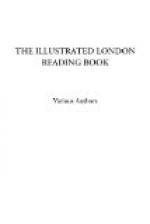F. Do rooks always keep to the same trees?
Mr. S. Yes; they are much attached to them, and when the trees happen to be cut down, they seem greatly distressed, and keep hovering about them as they are falling, and will scarcely desert them when they lie on the ground.
F. I suppose they feel as we should if our town was burned down, or overthrown by an earthquake.
Mr. S. No doubt. The societies of animals greatly resemble those of men; and that of rooks is like those of men in the savage state, such as the communities of the North American Indians. It is a sort of league for mutual aid and defence, but in which every one is left to do as he pleases, without any obligation to employ himself for the whole body. Others unite in a manner resembling more civilised societies of men. This is the case with the heavers. They perform great public works by the united efforts of the whole community—such as damming up streams and constructing mounds for their habitations. As these are works of great art and labour, some of them probably act under the direction of others, and are compelled to work, whether they will or not. Many curious stories are told to this purpose by those who have observed them in their remotest haunts, where they exercise their full sagacity.
F. But are they all true?
Mr. S. That is more than I can answer for; yet what we certainly know of the economy of bees may justify us in believing extraordinary things of the sagacity of animals. The society of bees goes further than that of beavers, and in some respects beyond most among men themselves. They not only inhabit a common dwelling, and perform great works in common, but they lay up a store of provision, which is the property of the whole community, and is not used except at certain seasons and under certain regulations. A bee-hive is a true image of a commonwealth, where no member acts for himself alone, but for the whole body.
Evenings at Home.
[Illustration: A HERONRY.]
* * * * *
PALMS.
These beautiful trees may be ranked among the noblest specimens of vegetation; and their tall, slender, unbranched stems, crowned by elegant feathery foliage, composed of a cluster of gigantic leaves, render them, although of several varieties, different in appearance from all other trees. In some kinds of palm the stem is irregularly thick; in others, slender as a reed. It is scaly in one species, and prickly in another. In the Palma real, in Cuba, the stem swells out like a spindle in the middle. At the summit of these stems, which in some cases attain an altitude of upwards of 180 feet, a crown of leaves, either feathery or fan-shaped (for there is not a great variety in their general form), spreads out on all sides, the leaves being frequently from twelve to fifteen feet in length. In some species the foliage is of a dark green and shining surface, like that of a laurel or holly; in others, silvery on the under-side, as in the willow; and there is one species of palm with a fan-shaped leaf, adorned with concentric blue and yellow rings, like the “eyes” of a peacock’s tail.




